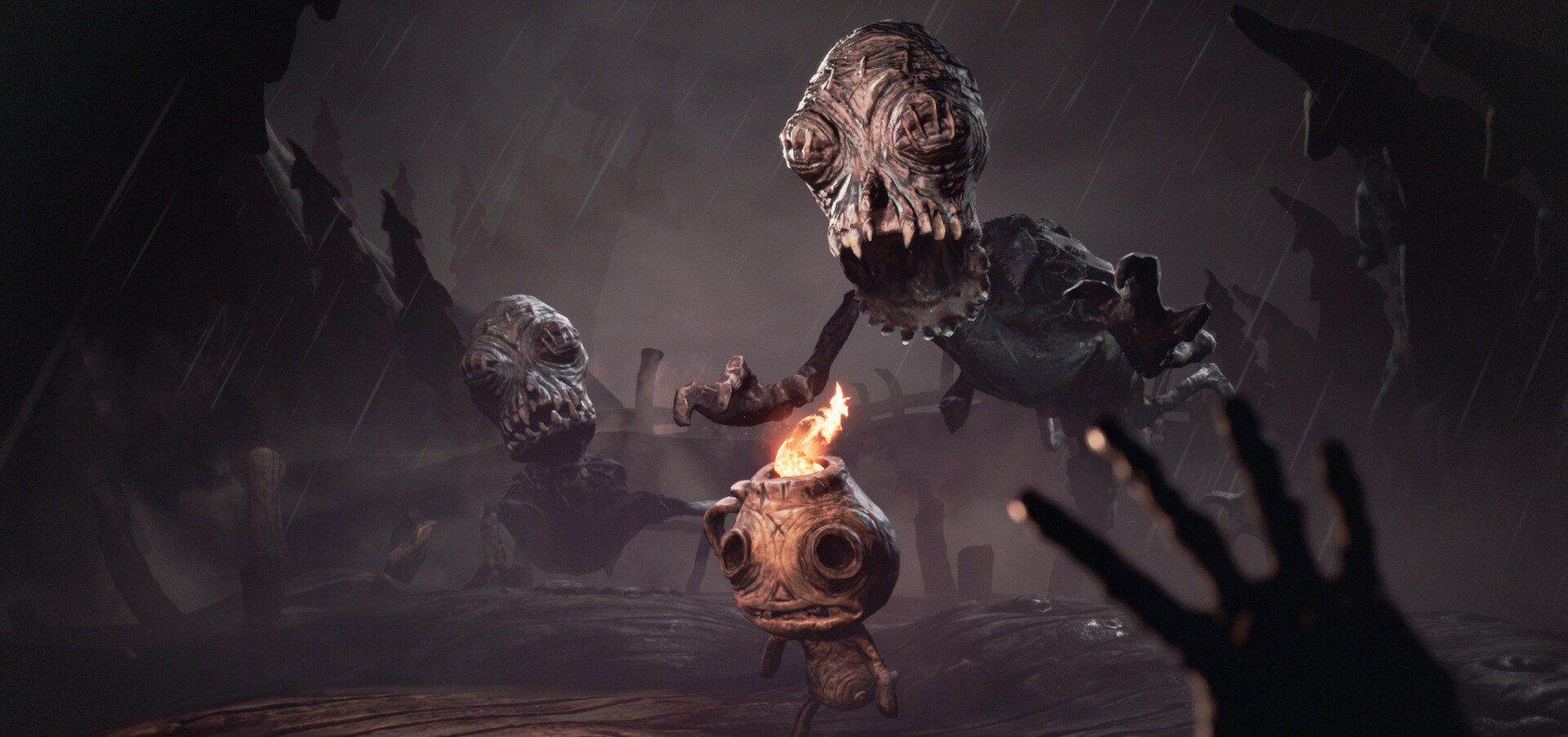The Midnight Walk is not your typical horror-adventure title. Developed by the creative minds behind Lost in Random, this game presents a beautifully macabre world sculpted from clay and powered by deeply emotional storytelling. It merges elements of dark fantasy, surrealism, and metaphor to create a meditative experience rather than a high-action thriller.
From its handcrafted visuals to its haunting sound design, The Midnight Walk is a metaphorical journey of hope through despair, as players guide a fragile flame through a world plunged into eternal night. Designed with VR in mind but equally immersive on standard platforms, the game proves to be a unique experience that stirs emotion more than adrenaline.

Story Overview – A Tale of Fire, Darkness, and Redemption
Enter the Burnt One and the Flame
The protagonist of The Midnight Walk is the “Burnt One,” a blind and deaf creature awakened in a world that has lost its Sun. Guided by makeshift senses provided by other beings, the Burnt One embarks on a journey with Potboy—a living clay cauldron containing the last flame of hope.
Together, they must reach the mythical Moon Mountain to rekindle the Sun and uncover the mystery of its disappearance. Along the way, they encounter numerous characters, each with their own story steeped in grief, fear, and redemption.
Road Movie Meets Dark Fantasy
The game unfolds like a dark road movie. Each chapter introduces a new setting, new characters, and micro-narratives that explore deeper human emotions—loss, resilience, inner warmth, and the power of companionship. This structure reinforces the idea that the journey is as important as the destination.
Gameplay Mechanics – A Walking Simulator with a Twist
Exploration, Puzzles, and Stealth
While The Midnight Walk might initially appear to be a “walking simulator,” it integrates engaging gameplay through exploration, light puzzle-solving, and stealth. There are no weapons to wield or enemies to defeat—only challenges to outsmart.
Puzzles primarily revolve around the symbolic use of fire. Whether lighting sequences to unlock a memory or sneaking past a monster by strategically using a flame, each puzzle emphasizes creativity over combat.
Sound-Based Gameplay and the Eyes-Closed Mechanic
One of the standout features is the ability to “close your eyes” to enhance your auditory senses. This is especially crucial in identifying the locations of hidden objects, or navigating the environment based on whispers, footsteps, or bell jingles.
In moments of terror, closing your eyes becomes a survival tactic. Some monsters can only be avoided in this state, adding a psychological dimension to gameplay, particularly gripping in VR.
Visual & Audio Presentation – A World Crafted by Hand
Claymation Brilliance and Symbolic Design
The game’s aesthetic is reminiscent of Little Nightmares and Tim Burton’s animated films like The Nightmare Before Christmas. Everything is crafted from clay models scanned into the game engine, giving the environment a tactile, eerie authenticity.
This artistic decision isn’t merely for visual appeal—it aligns with the theme of fire giving clay its form and soul, paralleling the game’s emotional arc.
Immersive Sound Design
Sound plays an essential role—not only in gameplay but in evoking the melancholic and eerie atmosphere. The violin-led score, ambient noises, and distant cries create an audio landscape that’s as integral to the experience as the visuals. Headphones are a must for the full effect.
Characters and Emotional Connection
Silent Companionship and Wordless Bonding
Despite no dialogue from the main characters, their silent interactions foster a powerful emotional bond. Potboy, the Cauldron, and the Burnt One express fear, joy, and determination through body language, sound cues, and actions. It’s a testament to the game’s narrative depth that such strong connections are built without a single spoken word.
Horror Elements – Darkness with Purpose
Monstrous Encounters
The game features grotesque monsters—twisted beings drawn to flame. From grinning spider-like entities to shadowy Crawlers, each is uniquely designed to instill fear. Encounters demand stealth and creativity, not brute force, making each escape a small victory.
Psychological Horror and Childhood Memories
Closing your eyes to evade monsters evokes childhood fears—the kind where hiding under the covers felt like a genuine defense. This mechanic taps into universal memories and brings a deeper layer to its horror.
Technical Performance and Platform Experience
VR Roots, PC Ready
While clearly optimized for VR, the game runs smoothly on traditional setups. With stable performance on high-end systems like the RTX 4070 Super, frame rates remain consistently high even during visually intense scenes.
Comfort and Accessibility
The game encourages headphone use for its 3D audio gameplay, which enhances immersion even on standard monitors. However, the lack of language localization, particularly in Russian, may pose barriers for non-English speakers. Fortunately, PC players can rely on community-created translations.
Final Verdict – A Poetic Adventure Worth Taking
The Midnight Walk isn’t for everyone. If you’re seeking high-paced action or deep mechanics, this may not be your game. But for those who appreciate symbolic storytelling, crafted visuals, and emotionally resonant journeys, it’s a hidden gem.
It’s more than just a game—it’s an interactive parable. One that explores the nature of inner fire, loss, and the hope that persists in even the darkest worlds.
Pros and Cons
Pros:
-
Hauntingly beautiful claymation visuals
-
Deep, emotional narrative without spoken dialogue
-
Innovative sound-based gameplay
-
Excellent soundtrack and sound design
-
Optimized well for PC despite VR focus
Cons:
-
Repetitive puzzles
-
Limited mechanical depth outside of VR
-
Excessive visual blur and darkness
-
Lack of multi-language support




